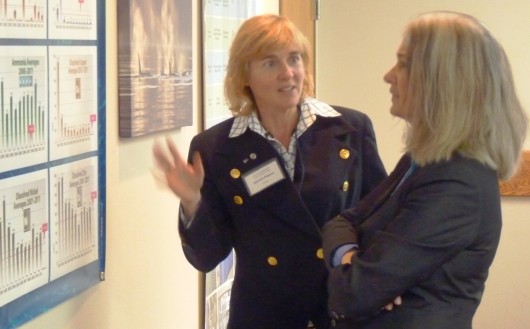
A report that could change the way cruise ships handle wastewater is nearly done. A state science advisory panel met Sept. 19-21 in Juneau and shared some of its work with the public.
Alaska’s Cruise Ship Science Advisory Panel has spent about two years looking at options for cleaning up wastewater. That includes discharges of harmful bacteria, dissolved metals and other pollutants.
Some ships already use systems that can meet elevated standards. Some do not, while others only discharge outside state enforcement boundaries.
The 11-member group finished its work on a preliminary report during its Juneau meeting. But the document still must undergo review. Division of Water Deputy Director Andrew Sayers-Fay says he hopes it’s available to the public by November 1st.
State Cruise Ship Program Manager Rob Edwardson says it’s an important step in a process started by the Legislature in 2009.
“The science advisory panel is using the preliminary report as a tool to assist and advise the commissioner on his report to the Legislature that’s due Jan. 1st, 2013,” Edwardson says.
A technology open house that was part of the science panel meeting presented the history of cruise ships in Alaska and current water-quality issues.

Edwardson says one is exploration of current cruise-ship systems.
“The second is the availability of additional methods that are economically feasible and technologically effective. And the third is the environmental cost and benefit of implementing any additional methods that they may find,” he says.
The feasibility issue is part of the Legislature’s charge to the panel. That led to examination of water-cleaning systems not yet used on the ships.
Sitka’s Steve Reifenstuhl represents the United Fishermen of Alaska on the science panel.
“We have looked at technology that is used in land-based facilities. There isn’t technology that has been used on cruise ships that can do that at this point. That’s not to say that it’s not feasible in the future – at a very high cost,” Reifenstuhl says.
Higher standards were called for in a 2006 Cruise Ship Initiative approved by voters, which also created a passenger head tax. (Hear a report on that initiative.) The panel was established as part of a compromise that delayed full enforcement.
Cruise lines argued the standards could be met by allowing discharges to be diluted through mixing zones. Basically, that means sampling water a distance from the ship, rather than from the discharge pipe itself.
Seattle environmental compliance analyst Lincoln Loehr represented the industry on the panel. He says water-cleaning systems in use now are about as good as it gets.
“I don’t see that there is convincing information on the effectiveness of these additional add-ons to consistently meet the water-quality criteria at the end of the pipe,” Loehr says.
Mixing zones, or other forms of dilution, are methods opposed by clean-water activists. (Hear a report on the mixing zone controversy.)
Loehr’s specialty is permitting municipal and industrial wastewater systems. He says cruise ships can make better use of mixing zones than land-based treatment plants.
“The criteria may be met for a municipality within 20 minutes or so. For cruise ships, when underway, they’re going to be met within less than 10 seconds,” Loehr says.
Critics say that would only spread out, not reduce damage to the marine environment.
Representatives of several companies selling water-treatment systems were at the open house.
Erik Neuman of California-based Rochem Membrane Systems says dilution is a key issue that could set an international precedent.
“And that is really the big question that the panel has and that Alaska has is to set that dilution level at a proper level that will really be the basis for other states and other countries to utilize in the future,” Neuman says.
The science panel also includes a marine ecologist, a government inspector, a ship-builder and an environmental engineering professor. Some members declined to comment after state officials instructed them to avoid lengthy interviews with reporters.
Reifenstuhl, who holds the panel’s fishing industry seat, says he’s optimistic about the final results.
“The goal is to protect Alaska’s waters and I think the science panel is going to come out with a report that will do that,” Reifenstuhl says.
The panel’s report to the Legislature is formally a preliminary document. But it’s unclear what might change between its release and the deadline for a final report two years later.
